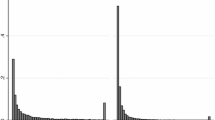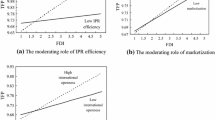Abstract
This paper finds that the nationality of ownership of foreign investors significantly impacts upon productivity spillover effects, revealing a curvilinear relationship with foreign direct investment on data for overseas Chinese (Hong Kong, Macau and Taiwan) multinational enterprises, but not for other (Western) firms. This relationship is most pronounced for low-technology host industries. These findings suggest that the curvilinear form is more appropriate to the future study of the spillover effects of foreign presence.
Similar content being viewed by others
Notes
The effect of productivity spillovers appears to be higher in cross-sectional studies than in panel data studies (Görg and Strobl, 2001).
In Caves' (1974) scheme, only the competitive effect may exert either a positive or negative impact on spillovers, with the precise effect depending on industrial conditions. For instance, the survival of the most efficient LOEs, given low barriers to exit, is one of the theoretically positive mechanisms. The majority of studies support a positive effect of competition on LOEs' productivity (Blomström, 1986; Wang and Blomström, 1992).
The appropriability ‘problem’ identified by Hymer (1960) and by Magee (1977) suggests that spillover benefits to rival LOEs will bear the signature of the foreign investor's technological advantages.
Smarzynska (2002) argues that market-oriented FDI generates more spillovers than export-oriented FDI. It is widely accepted that OTHER FDI is market-oriented and HMT FDI is more export-oriented (e.g., Buckley et al., 2002). This lends further support to our argument for a linear relationship between OTHER FDI and LOEs’ productivity.
The authors would like to thank an anonymous reviewer for suggesting this analysis.
The authors are grateful to an anonymous reviewer for pointing this out.
Editions of the Orientation Directory of Industries for FDI record the progress of laws and regulations relevant to specific sectors to comply with the State plan for national economic growth (Luo, 2000). Prior to 1978 inward FDI was prohibited. From 1978 to 1986 FDI was promoted in all but certain sensitive sectors (e.g., electricity, railways and financial services), but only in joint venture form. Controls on the numbers of foreign investors and ownership restrictions were then removed from 1987, with the exception of sectors of strategic importance (e.g., final assembly of transportation equipment, post and telecommunications network operation, power generation, aerospace and defence).
Shaver (1998) argues that failure to control for selection of industry may lead to biased results. Admittedly, this selection problem can be better addressed with panel data.
As is widely recognised in the literature, the fundamental problem with any instrumental variable is the difficulty of finding good instruments. There are no perfect instruments, and therefore caution must be exercised when interpreting results.
This lack of perceptible impact may be partly caused by the exclusion of all but seven FDI-restricted industries from the regressions on the grounds of incomplete data. After excluding these typically sensitive industries, for which the government is unwilling to divulge full information, fewer industries that are FDI restricted are left in our sample. The insignificance of the dummy variable suggests that the selection of sensitive industries by the government has been appropriate, with no locally owned industry suffering deleterious impacts through inadequate protection from inward FDI.
Most existing studies employ capital share to proxy foreign presence (FP). Following Blomström and Persson (1983), we also tried foreign employment share and found that this made no material difference to the results.
The F-test is a formal way to compare the linear with the curvilinear specification in the context of our model. Indeed, the existence of the significant FP hmt 2 term alone is sufficient to reject the linear specification.
The primary objective of this paper is to examine the form of the relationship between foreign presence and LOEs’ productivity. The key element of Hypothesis 2 is linearity rather than the sign of the relationship. Therefore, though FP other has a positive sign, Hypothesis 2 is rejected.
According to Buckley et al. (2002), HMT firms’ FDI is concentrated in light industries. Their capital shares in these industries are as follows (with OTHER capital penetration in brackets for comparison): other food processing, 0.211 (0.136); cake and sugar confectionery, 0.211 (0.127); soft drinks, 0.186 (0.128); knitting, 0.225 (0.076); other textile products, 0.278 (0.138); clothes, 0.239 (0.098); toys, 0.397 (0.058); household chemical products, 0.072 (0.254); fishing equipment and associated materials, 0.273 (0.091); rubber tyres, 0.077 (0.17); household plastic groceries, 0.268 (0.077).
The five breakpoints are very tightly clustered, and the choice of any of them makes very little difference to the size of the two subsamples. This also means that the selection of more than two subsamples is not feasible. We therefore chose the point with the highest significance.
The evidence is that SOEs conduct the overwhelming majority of R&D in Chinese-owned industry.
References
Aitken, B.J. and Harrison, A.E. (1999) ‘Do domestic firms benefit from direct foreign investment? Evidence from Venezuela’, The American Economic Review 89 (3): 605–618.
Blomström, M. (1986) ‘Foreign investment and productivity efficiency: the case of Mexico’, Journal of Industrial Economics 35 (1): 97–110.
Blomström, M. and Persson, H. (1983) ‘Foreign investment and spillover efficiency in an underdeveloped economy: evidence from the Mexican manufacturing industry’, World Development 11 (6): 493–501.
Buckley, P.J. and Casson, M. (1976) The Future of Multinational Enterprise, Macmillan: London.
Buckley, P.J., Clegg, J. and Wang, C. (2002) ‘The impact of inward FDI on the performance of Chinese manufacturing firms’, Journal of International Business Studies 33 (4): 637–655.
Caves, R.E. (1974) ‘Multinational firms, competition and productivity in host country markets’, Economica 41 (162): 176–193.
Davis, H. (1996) ‘High IQ and low technology: Hong Kong’, s Key to Success’, Long Range Planning 29 (5): 684–690.
Dunning, J.H. (1977) ‘Trade, Location of Economic Activity and the Multinational Enterprise: A Search for an Eclectic Approach’, in B. Ohlin, P.-O. Hesselborn and P.M. Wijkman (eds.) The International Allocation of Economic Activity, Macmillan: London, pp: 395–418.
Dunning, J.H. (1988) Explaining International Production, HarperCollins: London.
Dunning, J.H. (1993) Multinational Enterprises and the Global Economy, Addison-Wesley: Wokingham, Berks.
Economic Intelligence Unit (1994) ‘Making sense of Chinese statistics’, World Bank, 2 May 1994, pp: 5–6.
Feinberg, S.E. and Majumdar, K.S. (2001) ‘Technology spillovers and foreign direct investment in the Indian pharmaceutical industry’, Journal of International Business Studies 32 (3): 421–437.
Globerman, S. (1979) ‘Foreign direct investment and “Spillover” efficiency benefits in Canadian manufacturing industries’, Canadian Journal of Economics 12 (1): 42–56.
Görg, H. and Strobl, E. (2001) ‘Multinational companies and productivity spillovers: a meta-analysis’, The Economic Journal 111 (475): F723–F739.
Haddad, M. and Harrison, A. (1993) ‘Are there positive spillovers from direct foreign investment? Evidence from panel data for Morocco’, Journal of Development Economics 42 (1): 51–74.
Harrison, A. (1996) ‘Determinants and Consequences of Foreign Investment in Three Developing Countries’, in M. Robers and J. Tybout (eds.) Industrial Evolution in Developing Countries: Micro Patterns of Turnover, Productivity, and Market Structure, Oxford University Press: Oxford, pp: 163–186.
Hausman, J.A. (1978) ‘Specification tests in econometrics’, Econometrics 46 (6): 1251–1271.
Hsu, M. and Chen, B. (2000) ‘Labor productivity of small and large manufacturing firms: the case of Taiwan’, Contemporary Economic Policy 18 (3): 270–283.
Hymer, S. (1960) ‘The international operations of national firms: a study of direct foreign investment’, PhD Dissertation, Massachusetts Institute of Technology, Cambridge, MA (published by MIT Press, 1976).
Kay, J. (1993) Foundations of Corporate Success, Oxford University Press: Oxford.
Kokko, A. (1992) Foreign Direct Investment, Host Country Characteristics and Spillovers, Stockholm School of Economics: Stockholm.
Konings, J. (2000) ‘The effects of foreign direct investment on domestic firms: evidence from firm level panel data in emerging economies’, Discussion Paper No. 2586, Centre for Economic Policy Research, London.
Lecraw, D.J. (1993) ‘Outward direct investment by Indonesian firms: motivation and effects’, Journal of International Business Studies 24 (3): 589–600.
Lee, K. and Plummer, M.G. (1992) ‘Competitive advantages, two-way foreign investment, and capital accumulation in Korea’, Asian Economic Journal 6 (1): 93–114.
Liu, X. (1999) ‘Comparative Productivity of Foreign and Local Firms in Chinese Industry’, paper presented at the 26th Annual Conference of the Academy of International Business United Kingdom Chapter, University of Strathclyde, Glasgow, Conference proceedings.
Liu, X., Siler, P., Wang, C. and Wei, Y. (2000) ‘Productivity spillovers from foreign direct investment: evidence from UK industry level panel data’, Journal of International Business Studies 31 (3): 407–425.
Luo, Y. (1997) ‘Performance implications of international strategy: an empirical study of foreign-invested enterprises in China’, Group and Organization Management 22 (1): 87–116.
Luo, Y. (1998) ‘Industry attractiveness, firm competence, and international investment performance in a transitional economy’, Bulletin of Economic Research 50 (1): 73–82.
Luo, Y. (2000) Multinational Corporations in China: Benefiting from Structural Transformation, Copenhagen Business School Press: Copenhagen.
Magee, S.P. (1977) ‘Multinational corporations, the industry technology cycle and development’, Journal of World Trade Law 2 (4): 297–321.
MOFTEC (1996) Regulations Towards Foreign Direct Investment, Social Science Publishing House: Beijing.
Perez, T. (1997) ‘Multinational enterprises and technological spillovers: an evolutionary model’, Journal of Evolutionary Economics 7 (2): 169–192.
Rawski, G.T. and Xiao, W. (2001) ‘Roundtable on Chinese economic statistics introduction’, China Economic Review 12 (4): 298–302.
Shaver, M.J. (1998) ‘Accounting for endogeneity when assessing strategy performance: does entry mode choice affect FDI survival’, Management Science 44 (4): 571–585.
Shi, Y. (1998) ‘Technological assets and the strategy of foreign firms to enter the China market’, Journal of International Marketing and Marketing Research 23 (3): 129–138.
Shi, Y. (2001) ‘Technological capabilities and international production strategy of firms: the case of foreign direct investment in China’, Journal of World Business 36 (2): 184–204.
Singh, R. (1992) ‘Government introduced price distortion and growth, evidence from twenty nine developing countries’, Public Choice 73 (1): 83–99.
Smarzynska, B.K. (2002) ‘Does foreign direct investment increase the productivity of domestic firms? In search of spillovers through backward linkages’, World Bank Policy Research Working Paper 2923, October.
Wang, Y. and Blomström, M. (1992) ‘Foreign investment and technology transfer: a simple model’, European Economic Review 36 (1): 137–155.
White, H. (1980) ‘A heteroscedasticity consistent covariance matrix estimator and a direct test for heteroscedasticity’, Econometrica 48 (4): 817–838.
Wu, F. (2003) ‘Chinese economic statistics – Caveat Emptor’, Post-Communist Economies 15 (1): 127–145.
Zhou, D., Li, S. and Tse, D. (2002) ‘The impact of FDI on the productivity of domestic firms: the case of China’, International Business Review 11 (4): 465–484.
Zhu, G. and Tan, K.Y. (2000) ‘Foreign direct investment and labor productivity: new evidence from China as the host’, Thunderbird International Business Review 42 (5): 507–528.
Acknowledgements
We thank three anonymous referees and the JIBS Departmental Editor, Professor José Manuel Campa, for their very constructive comments on our earlier versions of this manuscript.
Author information
Authors and Affiliations
Corresponding author
Additional information
Accepted by José Manuel Campa, Deparmental Editor, 14 August 2006. This paper has been with the author for three revisions.
Rights and permissions
About this article
Cite this article
Buckley, P., Clegg, J. & Wang, C. Is the relationship between inward FDI and spillover effects linear? An empirical examination of the case of China. J Int Bus Stud 38, 447–459 (2007). https://doi.org/10.1057/palgrave.jibs.8400274
Received:
Revised:
Accepted:
Published:
Issue Date:
DOI: https://doi.org/10.1057/palgrave.jibs.8400274




